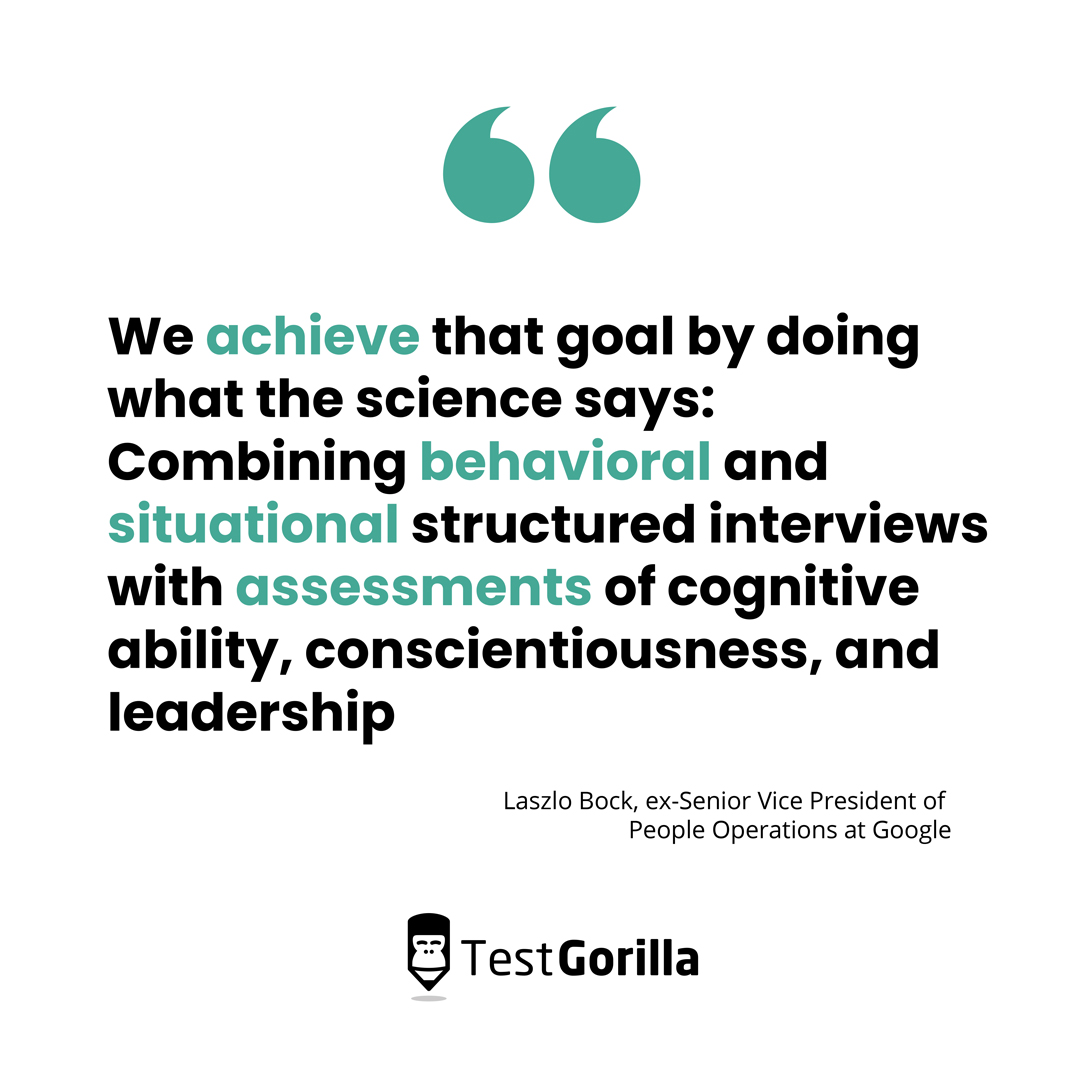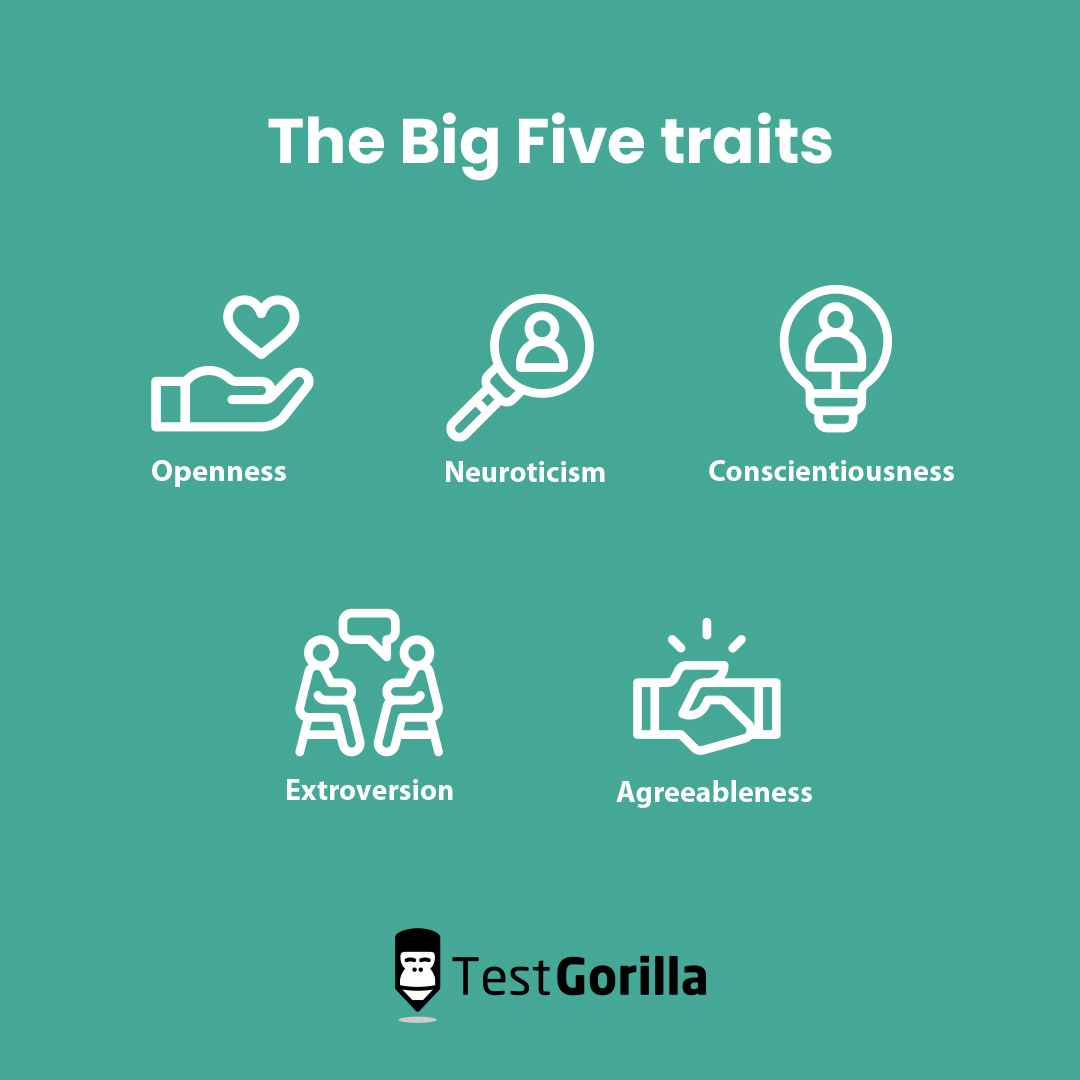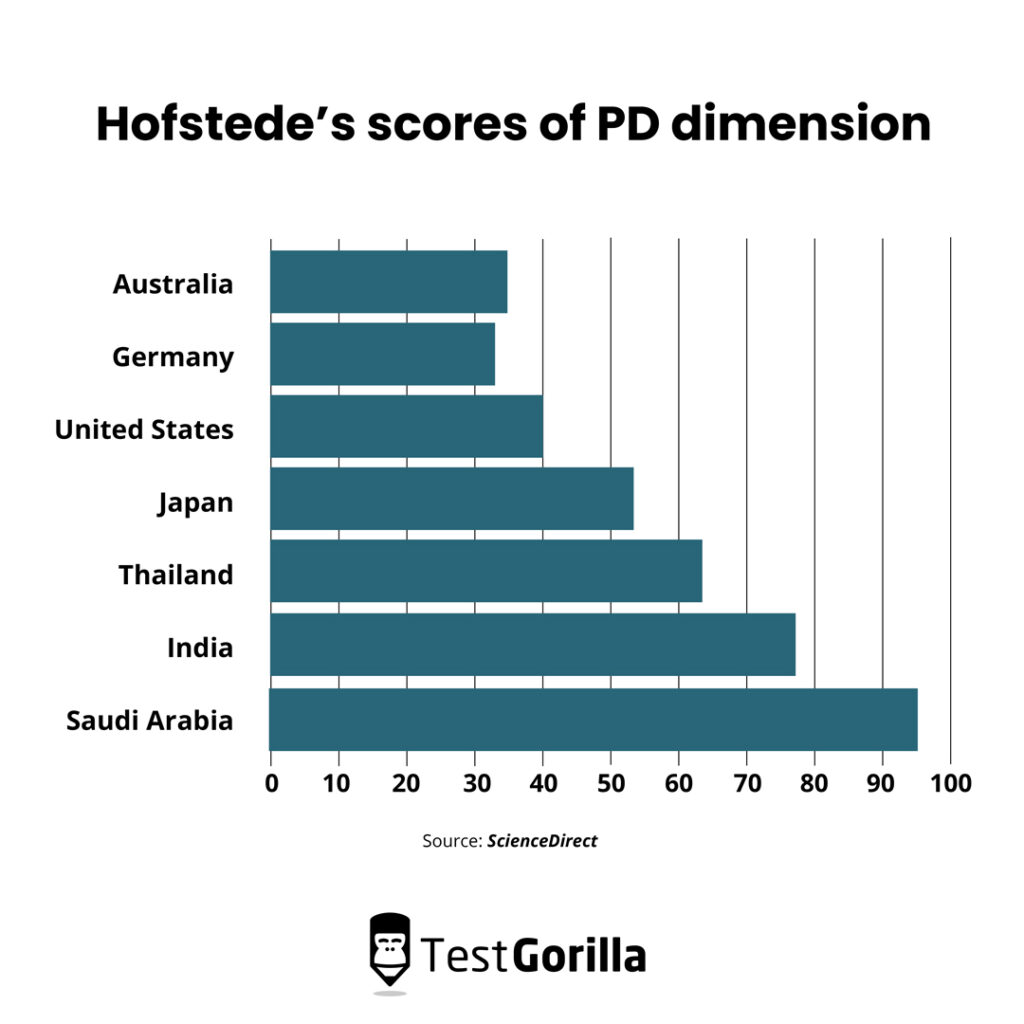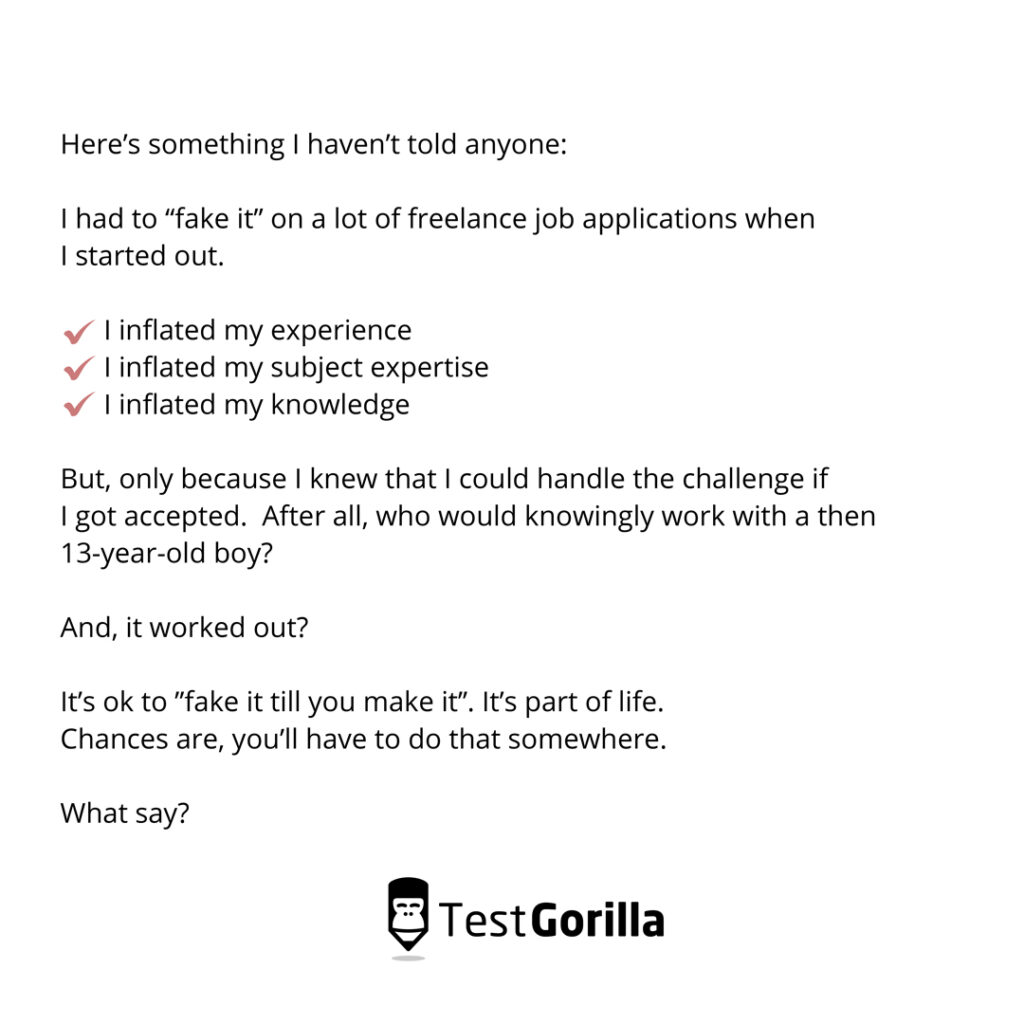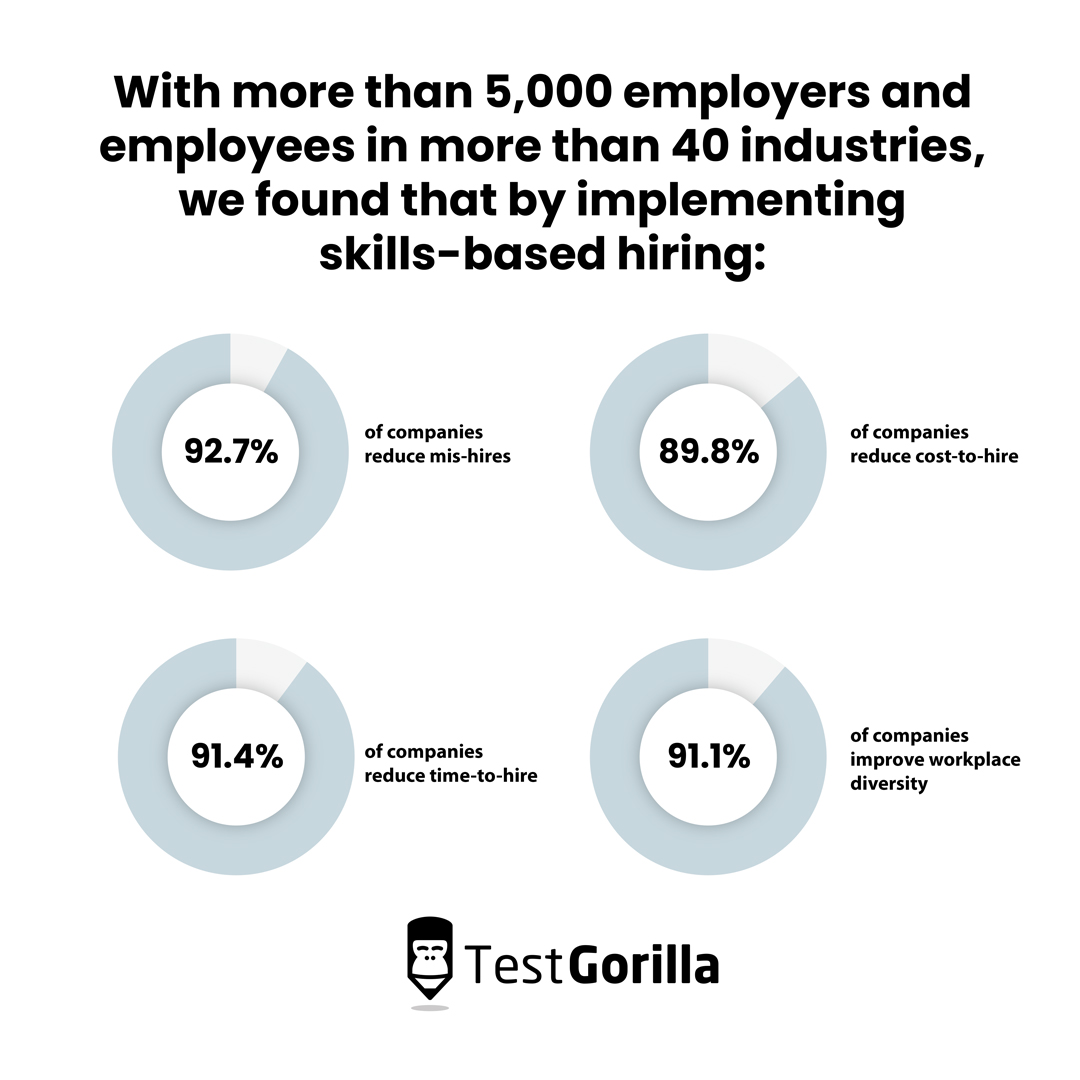How skills-based hiring helps remote-first companies hire the best candidates
On the surface, moving to a remote-first structure is a win-win.
It opens your company up to a wider talent pool, creates efficiencies by enabling you to build a team that runs 24 hours, and helps you build a diversity of experience, opinions, and expertise.
Employees love working in a remote-first environment because it gives them greater flexibility and autonomy, improving work satisfaction and creating a healthier work-life balance.
But there’s something most advocates of remote-first fail to explore: The intricacies and challenges involved in hiring for this style of organization.
As a remote-first company, TestGorilla has a ton of experience hiring internationally.
We’ve learned how remote-first requires a different approach to recruiting, one which helps hiring managers circumvent the challenges that remote hiring brings, as well as some of the age-old problems that existed before the world went remote.
In this article, we’re going to share the solutions we’ve found and discuss five critical challenges that remote-first hiring entails and how a skills-based approach to hiring helps solve them, deliver better candidates, and make the hiring process faster, cheaper, and more effective.
Table of contents
- Overcome flawed interview processes
- Build relationships on a foundation of trust, autonomy, and self-motivation
- Make the most of an international hiring pool
- Work faster by avoiding trial periods
- Quit being fooled by dishonest applicants
- Bridging the gap between remote-first goals and remote hiring challenges with skills-based hiring
Overcome flawed interview processes
The biggest and most obvious difference with remote-first hiring is that you don’t get to meet your candidates in person.
In the traditional hiring environment, the first step after receiving a round of applications is to hold in-person interviews.
Holding interviews over Zoom just isn’t the same.
Communication becomes more difficult due to connection issues, lag, and challenges reading body language and facial expressions.
This impacts your ability to judge a candidate’s communication skills (critical in many roles), as well as the degree of truth in their answers about work experience.
But here’s the thing:
Connection issues aside, interviews are flawed to begin with.
Unstructured interviews – the kind most hiring managers use – have a notoriously low validity coefficient for predicting success in employment.[1] This essentially means that the judgments you make based on an interview have very little correlation with what happens after you hire that person.
Beyond that, several studies demonstrate that a candidate’s self-confidence has a significant bearing on selection outcomes. That is, how your candidates present themselves can impact your decision-making process regardless of their experience, expertise, or suitability for the role.
Since the typical interview isn’t all that helpful anyway, and we’re exacerbating that by conducting them over a video call, why don’t we just do away with them altogether?
Google threw out the rulebook and canned interviews altogether when they found that they predicted only 14% of future performance on the job.[2]
What did they do instead? Google set a goal of using the application process to accurately predict how candidates will perform once hired, then followed the science:
“We achieve that goal by doing what the science says: Combining behavioral and situational structured interviews with assessments of cognitive ability, conscientiousness, and leadership.”
Laszlo Bock, ex-Senior Vice President of People Operations at Google
Structured interviews – where the applicant is asked a series of predetermined questions with the criteria for successful answers already defined – have a much higher validity coefficient (0.44), second only to work samples (0.54).[1][3]
Combining structured interviews with tests that assess cognitive ability and conscientiousness creates a well-rounded candidate assessment process that better predicts success on the job.
Plus, it helps remove some of the internal biases that impact your judgment during interviews (60% of interviewers take just 15 minutes to make up their minds about a candidate).[4]
Head here to learn how to adopt skills-based hiring practices in your organization.
Build relationships on a foundation of trust, autonomy, and self-motivation
The second problem that emerges with remote recruiting happens after you’ve got your new applicants on board.
The fact that your new hires aren’t working in the same office as you creates a concern for accountability, because you’re not there seeing them complete the actual work.
Of course, there is an element of trust that needs to be present here.
Managers need to trust that their employees will work diligently and not take advantage of the fact that nobody is supervising them. You don’t want to become that micromanager that tracks every single click or action they take – that’s not a foundation for a healthy work relationship.
But here’s the thing:
Some people are simply more diligent, self-motivated, and independent than others. With any kind of personality trait, there are going to be some people who exhibit that trait highly and others less so.
It’s no surprise, then, that this survey from Workable found that the second most desirable trait in a post-COVID work environment (where remote work is much more common) is self-motivation.
So, how do you identify applicants that are self-motivated, responsible, and dependable?
You can’t just ask, “Can you work autonomously?” (Who is going to answer “no” in an application for a remote role?)
Instead, you can test for the psychological trait known as conscientiousness.
Conscientiousness is one of five psychological traits known as The Big Five.) (the other four being openness, extroversion, neuroticism, and agreeableness). This is a well-recognized personality model and one of the most robust and valid around.
Because the trait conscientiousness has been found to be a predictor of work success and is particularly important in understanding an applicant’s tendency to work autonomously, testing for conscientiousness using The Big 5 (OCEAN) personality test should be an important component in your remote hiring process.
You should supplement this assessment with a test that measures a candidate’s job motivation levels.
Different employees are motivated by different drivers and moderators.
For example, some are more intrinsically motivated, some require a higher degree of responsibility to feel motivated, and others are more extrinsically motivated by the compensation and benefits your organization offers.
TestGorilla’s motivation test, based on Hackman and Oldham’s Job Characteristics Model, helps you determine whether a candidate’s preference and motivations align with what your job has to offer.
The best insights on HR and recruitment, delivered to your inbox.
Biweekly updates. No spam. Unsubscribe any time.
Make the most of an international hiring pool
One of the biggest benefits offered by moving to a remote-first company structure is the fact that it opens you up to an international hiring pool.
This is particularly important right now since 87% of companies say they have a skills gap or expect to have one within a few years.
But hiring internationally brings with it a number of challenges that extend beyond having to deal with multiple time zones.
Cultural differences related to hierarchies, communication, and working style can all present challenges to an existing establishment.
This is about more than eliminating discrimination (though that’s important too). It’s about creating a work environment where employees are sensitive to these subtle yet powerful cultural differences and understand how to navigate them.
Take, for example, cultural differences with regard to hierarchy, communication, and respect.
After studying employees of IBM in more than 50 different countries, psychologist Dr. Geert Hofstede identified several dimensions which describe different cultures. One of which, known as Power Distance Index (PDI), describes the degree of inequality that exists and is accepted between those with and without power.
Countries that have a high PDI accept a more unequal and hierarchical distribution of power and tend to frame this distribution as “knowing their place” and “having respect” for those in power positions.
These cultural differences have implications for communication in the workplace.
As Malcolm Gladwell identifies in his book Outliers, which explores the factors that contribute to high degrees of success, we’re able to observe that workers from cultures with a high PDI are less likely to speak up and challenge their superiors and are instead likely to stay silent and do as instructed.
This can have disastrous consequences.
Gladwell’s exploration of PDI differences focused on the reasons why airlines from countries like Colombia and South Korea had such high rates of crashes (their high PDI culture impacted their ability to communicate effectively in an emergency situation).
In the workplace, this can lead to employees feeling undervalued or unsatisfied with their work and prevents your company from drawing on the diversity of ideas and experiences of your people.
It can also be a cause of workplace conflict when the roles are reversed.
Employees from low PDI countries are more likely to be assertive and to challenge authority or suggest alternative methods of working. If their manager is from a high PDI culture, they could interpret this as disrespectful, resulting in a conflict between the two parties.
Aside from fostering a work environment that promotes cultural awareness and discusses the sources of difference such as these, one way you can improve cohesion in an international workplace is to use assessments during the hiring process.
Communication skills tests can be used to assess an applicant’s ability to communicate diplomatically, open-mindedly, confidently, and empathetically.
These tests can be combined with personality tests like The Big Five assessment we discussed earlier.
By testing for openness, a psychological trait that relates to intellectual curiosity, emotional awareness, broad-mindedness, and acceptance, you’re able to screen for candidates who are better prepared to navigate a vast landscape of cultural and communication differences.
Work faster by avoiding trial periods
Many companies who adopt a remote-first structure attempt to solve the problem of hiring uncertainty (resulting from ineffective video interviews and discomfort related to accountability) by using trial periods to “try before they buy.”
Whilst trials can be effective for assessing an applicant’s suitability for the role, they drag out the hiring process unnecessarily.
Think about it; you can only run so many trial periods at a time.
If you’re hiring to fill just one position, you probably only commit to one applicant in a trial period because the assumption is that you’ll hire them permanently if the trial period works out.
But what if it doesn’t? You’re back to square one. Repeat that three times, and you’re a whole quarter behind without a permanent employee in the role.
A skills-based hiring methodology solves this challenge by using highly-relevant and situational work assessments to judge applicant suitability.
Rather than committing to just a single trial period (which, by the way, you’ll be paying your applicant for), you can run multiple pre-employment tests simultaneously.
Each time you receive a new application that is potentially appropriate for the role, you can move forward immediately with testing.
If you’re running trial periods, though, you have to wait to receive all the applications before deciding on the best applicant with whom to proceed.
As a result, eliminating trial periods in favor of skills testing creates a far more efficient and agile hiring process. It also creates better hires; hiring managers who use pre-employment tests are 36% more likely to be satisfied with their hiring decision, meaning they’re better at hiring right the first time.[5]
Quit being fooled by dishonest applicants
How often do you think your job candidates lie on their applications?
Hint: It’s probably more often than you expect.
In this survey, 55% of Americans admitted to lying about their experience, education, or skills on a resume.
This means that more applicants lied than didn’t.
In the context of remote work, this is likely to get worse because applicants can hide behind their keyboards without the fear of getting called out in a face-to-face interaction.
Some might go as far as flaunting their success using outright lies to secure remote work:
There are several reasons that lead candidates to lie on applications, but the overarching driver is the need to stand out in a competitive hiring landscape.
Your best bet in combating this is to do away with resumes altogether. They’re terrible predictors of future performance anyway, worse even than unstructured interviews.[6]
Instead, replace resumes with role-based pre-employment tests.Candidates can lie about their experience or education, but they can’t fake their performance on a test.
Bridging the gap between remote-first goals and remote hiring challenges with skills-based hiring
Remote work is empowering for employees and opens up a world of opportunities for hiring managers and their organizations.
But it requires a different approach to hiring.
By focusing on demonstrable skills rather than education or experience, you can get around some of the challenges of remote hiring, like ineffective video interviews, the increased need for trust and accountability, and cultural communication differences.
By using automated assessments, you can build a more efficient screening stage, enabling you to focus the bulk of your time and energy on running structured interviews to pinpoint the best talent from a group of people you know have the skills to succeed.
But don’t just take our word for it. In Deloitte’s survey of skills-based organizations, they found that companies that took this approach were:
107% more likely to place talent effectively
98% more likely to retain higher performers
98% more likely to have a reputation as a great place for career development
In our own survey of more than 5,000 employers and employees in more than 40 industries, we found that by implementing skills-based hiring:
92.7% of companies reduce mis-hires
91.4% of companies reduce time-to-hire
89.8% of companies reduce cost-to-hire
91.1% of companies improve workplace diversity
Want to find out more? Download The State of Skills-Based Hiring 2022 report here.
You've scrolled this far
Why not try TestGorilla for free, and see what happens when you put skills first.


